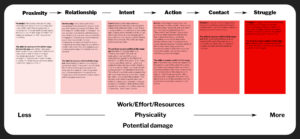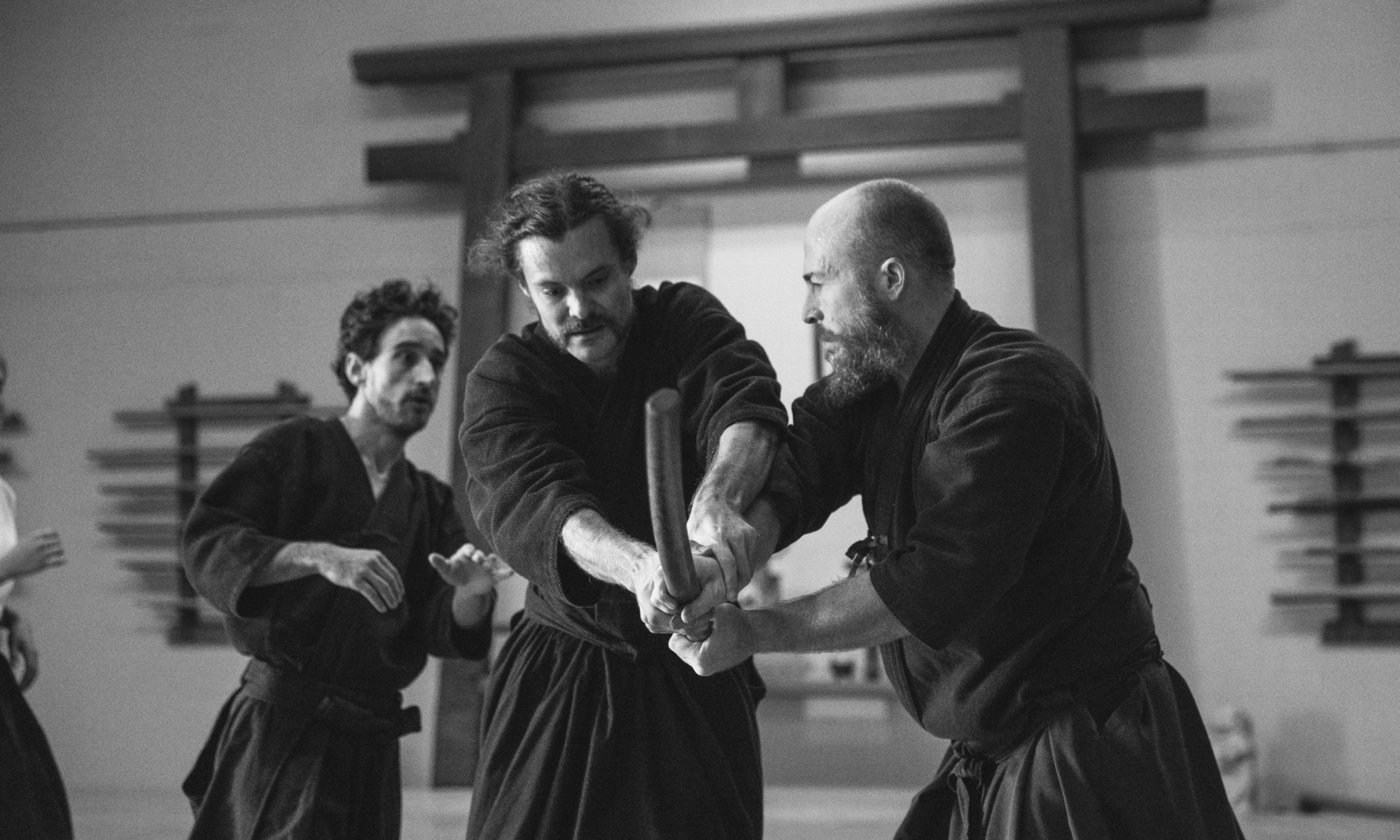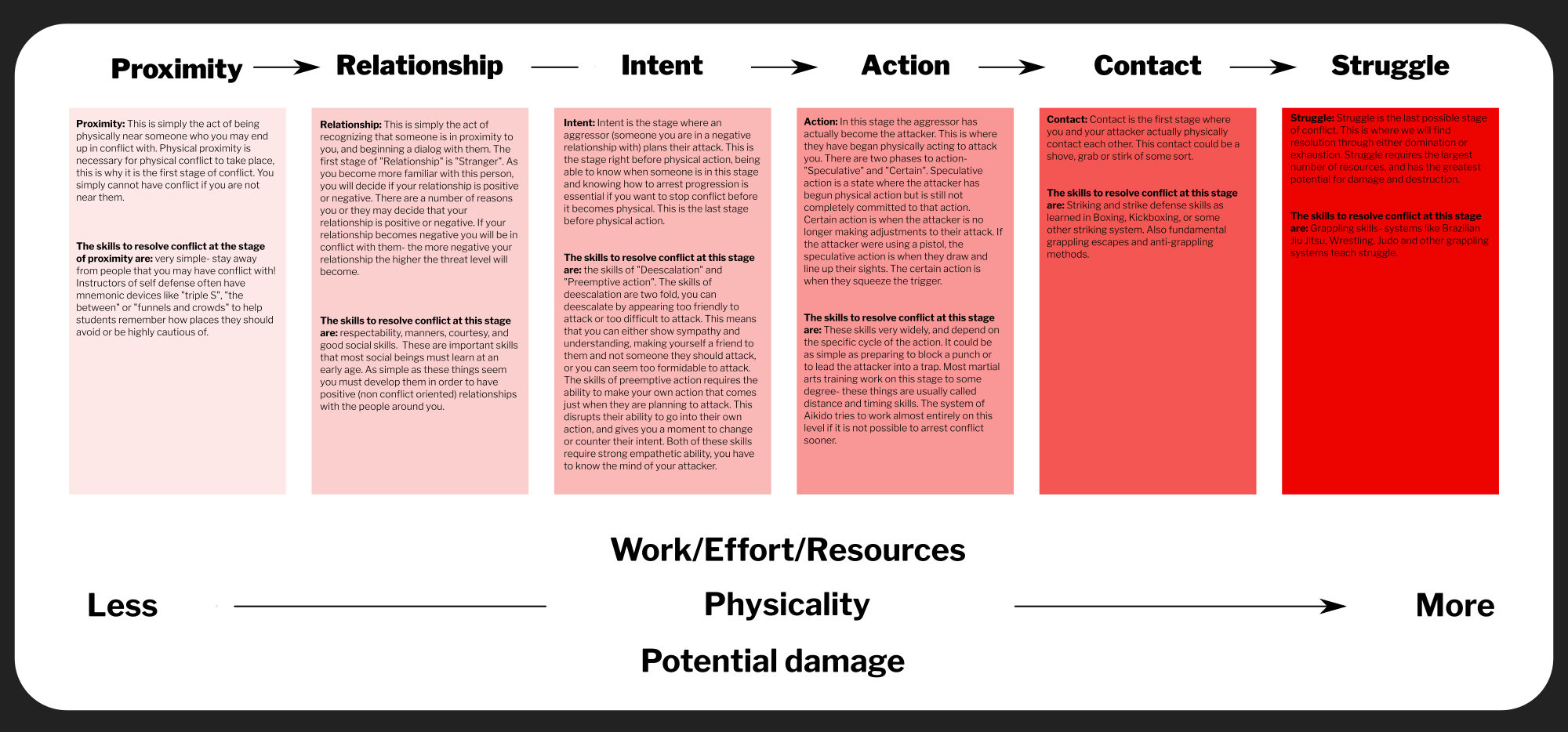The spectrum of conflict.
When people want to study martial arts, what they are looking to study is conflict and the ways one can deal with conflict. It’s important to understand that conflict has many stages and each stage requires a different skill set. As a student of Aikido, understanding these different stages and where our martial art fits on this gradient will help you to better understand what Aikido is trying to help you learn.
When people study martial arts, they will often say “I’m learning to fight”, but in a martial art like Aikido we often specifically say “Aikido isn’t about fighting”. So how can Aikido both be a martial art and not teach about fighting? All martial arts are about conflict- specifically systems of dealing with conflict in a personally beneficial way. Aikido is no different- in Aikido we are training to deal with conflict in a way that is personally beneficial, and, if at all possible, not too damaging to the person that attacks us! It’s that last part- doing our best not to harm our attacker- that leads us to form this opinion that Aikido is not fighting. Aikido can be a martial art and have nothing to do with fighting because all not conflict is a fight!
All conflict isn’t a fight. It’s kind of like how a rectangle is not a square but all squares are rectangles. Conflict isn’t always a fight, but all fights are conflict. Thus, conflict is a larger category than fighting is. Fighting denotes a struggle between two (or more) parties, while conflict is simply an opposition of ideas, motives or actions. Conflicts often become fights, but humans have learned other ways to solve problems, ways outside of fighting. For example, compromise is a way to avoid having to fight. A compromise happens when differing parties make concessions and blend together their different ideas, motives or actions in order to come to an agreement. Another word we often use to describe this idea is “accord”. Accord is the word I would say best describes Aikido training. Accord means making certain concessions in order to achieve a desirable agreement. An accord is in no way a fight- but is born of conflict. Accord is a way of arresting conflict before it degenerates into a fight, or to put it more simply, struggle.
When I say arresting conflict before it degenerates into struggle, I’m eluding to a spectrum of conflict. Conflict doesn’t start at struggle- it ends there. There are many opportunities before struggle to resolve conflict. Aikido seeks to do just that- resolve the conflict before it becomes struggle. Below I have illustrated the gradient of conflict- take a look at each of the stages and notice how they all require different skills of resolution. Also notice where Aikido sits on this spectrum.

Having looked at the spectrum, I want you to stop and realize how powerful it is. If you understand what the spectrum is showing you, you’ll see that by understanding these stages and the tools you’ll need to resolve problems at these stages you can be well ahead of struggle! This model can help you to organize the information you’ll need to be most successful at each stage of conflict.
Let’s talk for a minute about the spectrum and exactly what it’s showing us! All conflict starts with “Proximity”:
Proximity simply means being close by- in this article we are talking about physical conflict, so physical proximity is essential for conflict to arise. However proximity could also mean proximity through correspondence like on the internet or broadcast, et cetera.
Relationship. Conflict will truly start to arise at the stage of “Relationship”. While it might sound strange, every time you are close to someone you enter into a relationship with them, the first rung on the ladder of this relationship is “stranger”. Through various means we move up and down on the ladder of relationship with people- if our interaction is pleasant they become someone we “Like”, if we trust them with details of our life and that goes agreeably they become a “friend”, and so-on. If our interaction is unpleasant they become someone we “Don’t like”, worse still is someone we hold in “Contempt”, as we go further down this ladder, we begin to have physical impulses towards harming this person- here is where we enter into the stage of “Intent”.
Intent is where I start to actually plan out what I want to physically do to the other person. Whether this plan is as simple as visualizing punching them in the face, or as complex as manipulating or trapping them down the road, the stage of intent always comes before “Action”.
Action has two phases, “Speculative” and “Certain”, but both stages require physical action on the part of the attacker. This action is what they use to achieve their goal- it could be sneaking up behind you two days from now, or directly lunging at you. The stages of “Intent” and “Action” is where Aikido works the most, this is why we are required to have Kokyu (relaxed ready), Musubi (binding of intent) and Awase (blending of physical action). If we can not resolve the problem at the level of “Action”, we move down the spectrum to “Contact.”
Contact is the first time the body is physically met. This meeting could be a punch or a grab, it could come from a foot, or a bullet, it is simply making a point of contact, be it soft or violent. If the conflict isn’t resolved at “Contact” we will move down to “Struggle”.
Struggle is the last stage of conflict, here we will reach a resolution one way or another. While all conflict naturally moves towards struggle, it’s important to realize that there are many ways to arrest this progressions before the struggle happens. Struggle requires more work and has a higher potential for danger than any of the other stages. Struggle is the least ideal way to end conflict, and should be avoided if at all possible.
This spectrum can also show you why many of these skills you learn in Aikido are much more practical than those you might learn in other martial arts systems. I say more practical because for most of us, solving a problem before it comes to physical blows is much more ideal than having to headlock someone! However it is also important to understand when looking at this spectrum that Aikido is limited (as are all things) in its area of effectiveness- if you want struggle skills, you’ll need to learn a system that teaches those. As I see Aikido, it works mostly with Intent and Action. We do some work in contact, but mostly we’d like to avoid it. By doing this we limit the amount of physicality needed- why children and old people should be able to do Aikido.
Understanding this spectrum can help you to understand our art and, even better, martial arts as a whole! Go study!

